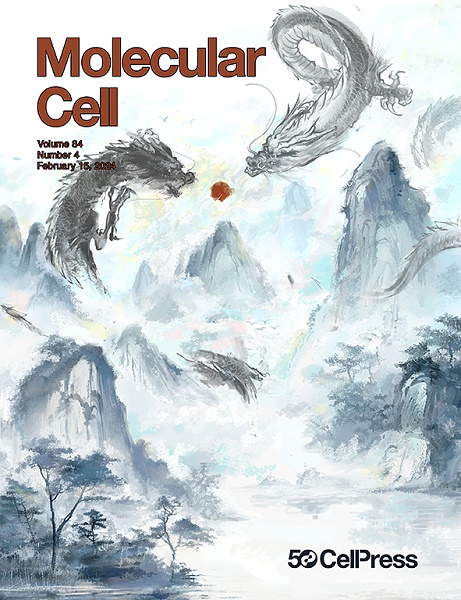Structural basis of human CHD1 nucleosome recruitment and pausing
IF 14.5
1区 生物学
Q1 BIOCHEMISTRY & MOLECULAR BIOLOGY
引用次数: 0
Abstract
Chromatin remodelers regulate gene expression and genome maintenance by controlling nucleosome positioning, but the structural basis for their regulated and directional activity remains poorly understood. Here, we present three cryoelectron microscopy (cryo-EM) structures of human chromodomain helicase DNA-binding protein 1 (CHD1) bound to nucleosomes that reveal previously unobserved recruitment and regulatory states. We identify a structural element, termed the “anchor element,” that connects the CHD1 ATPase motor to the nucleosome entry-side acidic patch. The anchor element coordinates with other regulatory modules, including the gating element, which undergoes a conformational switch critical for remodeling. Our structures demonstrate how the DNA-binding region of CHD1 binds entry- and exit-side DNA during remodeling to achieve directional sliding. The observed structural elements are conserved across chromatin remodelers, suggesting a unified mechanism for nucleosome recognition and remodeling. Our findings show how chromatin remodelers couple nucleosome recruitment to regulated DNA translocation, providing a framework for understanding chromatin remodeler mechanisms beyond DNA translocation.

人CHD1核小体募集和暂停的结构基础
染色质重塑子通过控制核小体定位来调节基因表达和基因组维持,但其调控和定向活性的结构基础仍然知之甚少。在这里,我们展示了人类染色质区域解旋酶dna结合蛋白1 (CHD1)与核小体结合的三种低温电镜(cro - em)结构,揭示了以前未观察到的募集和调节状态。我们确定了一种结构元件,称为“锚定元件”,它将CHD1 atp酶马达连接到核小体入口侧的酸性斑块。锚定元件与其他调控模块协调,包括门控元件,门控元件经历了对重塑至关重要的构象转换。我们的结构展示了CHD1的DNA结合区如何在重塑过程中结合入口和出口侧DNA以实现定向滑动。观察到的结构元件在染色质重塑中是保守的,这表明核小体识别和重塑的统一机制。我们的研究结果显示了染色质重塑子如何将核小体募集与调节的DNA易位结合起来,为理解染色质重塑子在DNA易位之外的机制提供了一个框架。
本文章由计算机程序翻译,如有差异,请以英文原文为准。
求助全文
约1分钟内获得全文
求助全文
来源期刊

Molecular Cell
生物-生化与分子生物学
CiteScore
26.00
自引率
3.80%
发文量
389
审稿时长
1 months
期刊介绍:
Molecular Cell is a companion to Cell, the leading journal of biology and the highest-impact journal in the world. Launched in December 1997 and published monthly. Molecular Cell is dedicated to publishing cutting-edge research in molecular biology, focusing on fundamental cellular processes. The journal encompasses a wide range of topics, including DNA replication, recombination, and repair; Chromatin biology and genome organization; Transcription; RNA processing and decay; Non-coding RNA function; Translation; Protein folding, modification, and quality control; Signal transduction pathways; Cell cycle and checkpoints; Cell death; Autophagy; Metabolism.
 求助内容:
求助内容: 应助结果提醒方式:
应助结果提醒方式:


